I received this wonderful email today, and I wanted to share it with you. I just love all these different ideas how you can make your curtains look special.
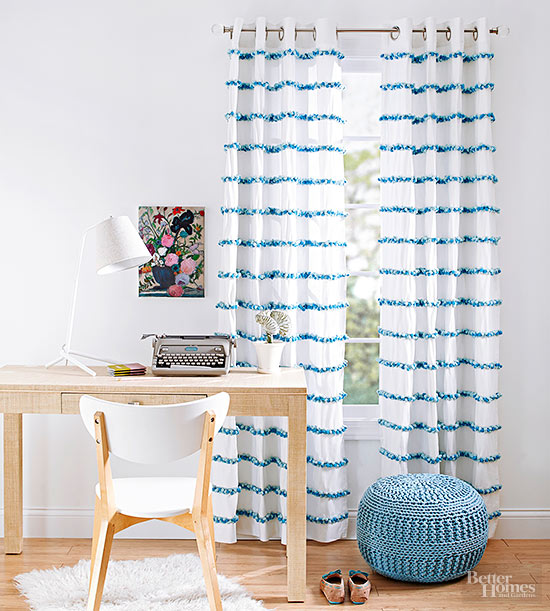
Pom-Pom Pep-Up
Give plain curtains a cheery boost by attaching rows of colorful pom-pom trim. Measure and mark parallel lines 6 inches apart across each panel using a fabric-marking pencil and measuring tape. To prevent puckering, glue 1-inch pom-pom trim to half of each drawn line at a time, allowing it to dry before gluing the other half. (We used Fabri-Tac, a permanent fabric glue.) To achieve a fuller effect, add additional strands of trim. (We used three strands — two light and one dark — for each row.)
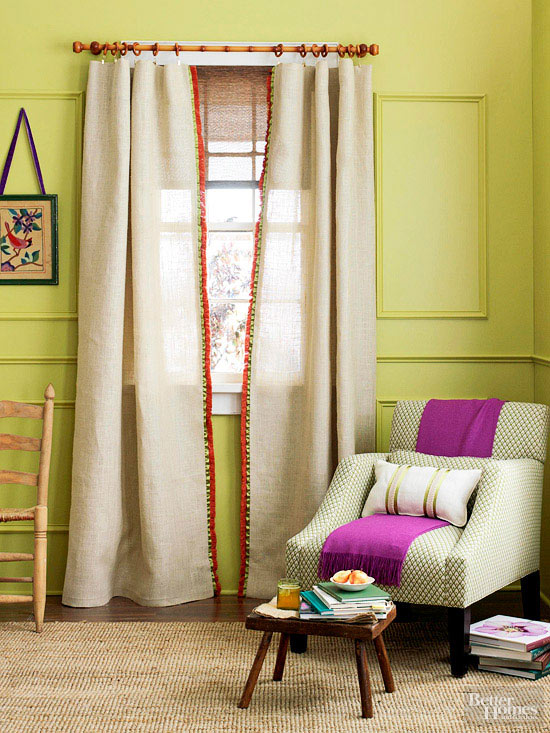
Burlap Curtains
Made into generous panels, affordable burlap has the look of linen at a fraction of the cost. Most burlap comes 50 to 60 inches wide, perfect for a panel. Just cut it to length (you’ll need about 3 yards per panel) and hem the sides with iron-on seam tape. The luxe textures of brush fringe and satin ribbon take humble burlap up a notch. To trim a curtain panel as shown here, lay the curtain panels out flat, wrong side up. Glue ribbon to the inside edge of the panel so about half an inch of ribbon peeks out, gathering the ribbon as you glue to make a slight ruffle. Then, glue the flat part of fringe material to the ribbon so the fringe extends about an inch beyond the ribbon. Trims usually can’t be machine-washed, so it’s best to spot-clean trimmed curtains.
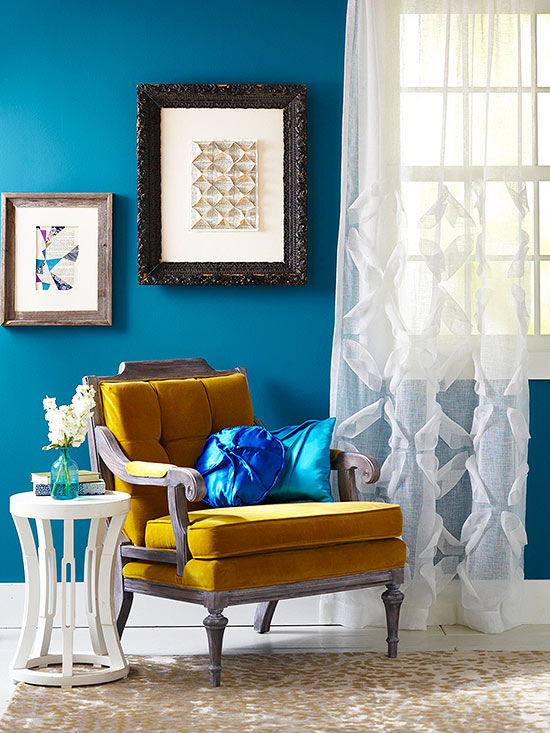
Tuck and Fold
An orgami-inspired folding technique turns plain window sheers into a one-of-a-kind creation. To create the curtain, purchase two sheer window panels. Cut the first into equal-size squares. Lay the other panel on the floor. On the squares, pin opposite corners in the center of the squa
re. Then lay the pinned pieces on the full panel in a pattern of your liking, overlapping the corners slightly. (We repeated an X shape to cover the lower portion of the sheer.) Hand-sew centers at the pins.
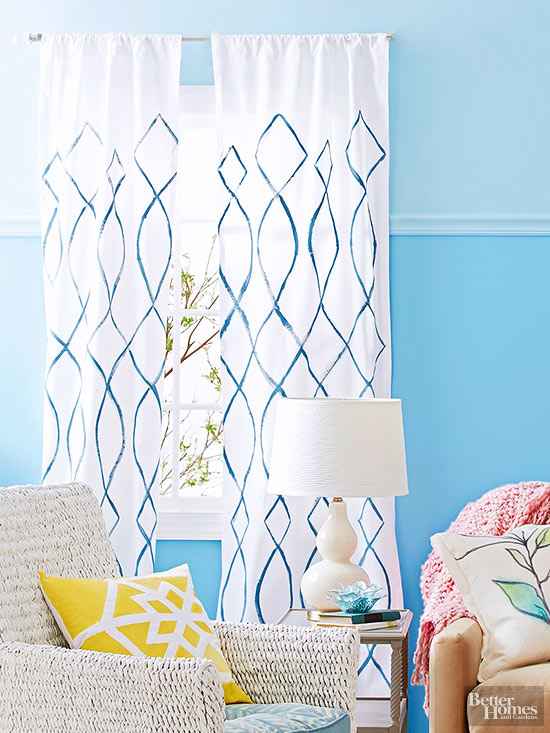
Stenciled Design
For this shapely teal design on crisp white drapery panels, trace desired shapes onto cardboard and cut out. (Get the pattern used for these curtains below.) We used two sizes of diamond shapes and one football shape. Iron the curtain panel and lay flat on a protected work surface. Position the first shape at the bottom left-hand corner of the panel. Trace around the shape using an artists brush and slightly watered-down teal blue paint. Place a second shape above the first and trace with paint. Keep alternating shapes to the top of the panel, then begin another row next to the first. For an organic look, we let our brushstrokes be imperfect.
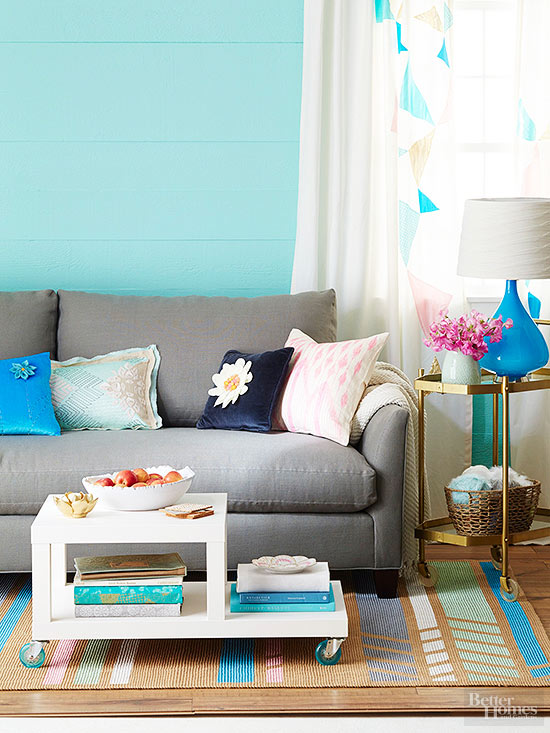
From All Angles
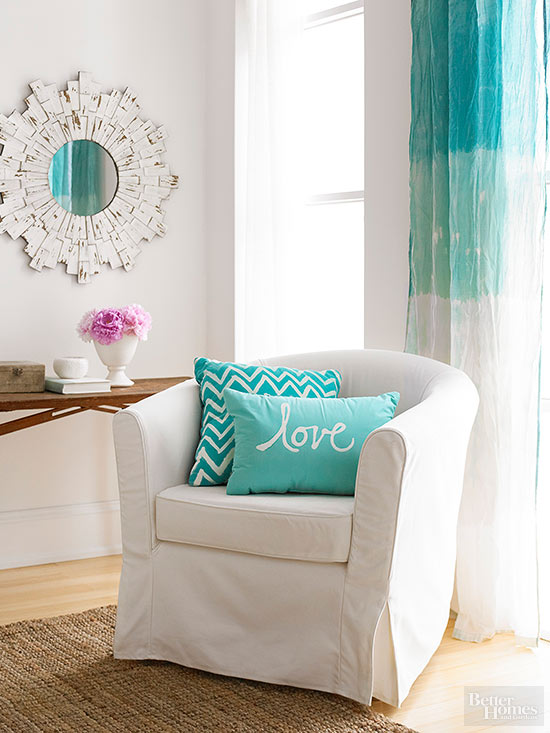
-
Dyed Curtains
Create an ombre effect by dipping a teal cotton curtain into equal parts bleach and water. Soak the bottom two-thirds of the curtain for five minutes, then lay it outdoors in the sun to dry. When the curtain reaches the desired shade, rinse with water. Repeat the process, soaking only the bottom third in the bleach-water solution. Allow the curtain to dry in the sun until the bottom portion is almost white. Rinse and let dry.
Tips:
- Safety first! Keep bleach out of reach of children, and work in well-ventilated areas. Always wear eye protection. If you have sensitive skin or abrasions, wear gloves. To prevent damage from splatters, protect the area around you and wear old clothes. Never mix bleach with other cleaning products.
- Fabric matters! For best results, choose natural dyed fabrics, such as cotton or linen, or 50/50 blends. Avoid 100 percent synthetic fibers (such as polyester), because they are typically colorfast.
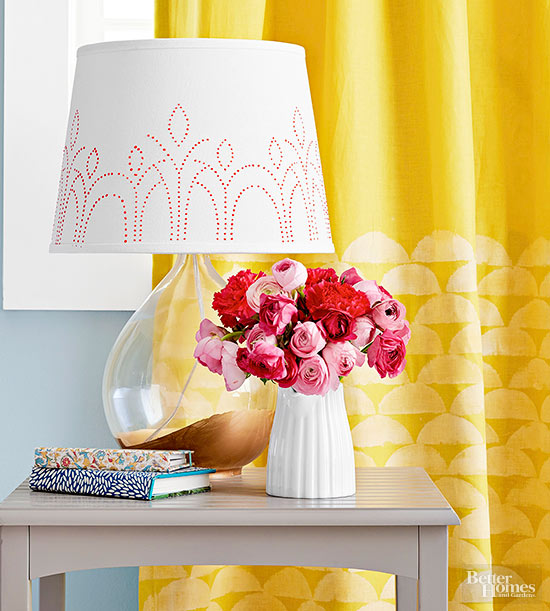
Reverse Engineering
Add a design to a colored curtain panel by subtracting hues. Intrigued? We were, too! We found a product called DeColourant that removes pigment from fabric. To create this scalloped pattern, all you need is a cheap plastic protractor (the grade-school kind), a stencil brush, DeColourant, and an iron. Position the protractor horizontally on your 100-percent cotton or silk fabric, then apply DeColourant to the fabric inside the arch of the protractor using the stencil brush. Move the protractor horizontally across the fabric and repeat the process to achieve rows. Allow the DeColourant to dry, then set an iron to the highest steam setting and press it over the fabric. When heated, the DeColourant lifts the hue from the fabric.
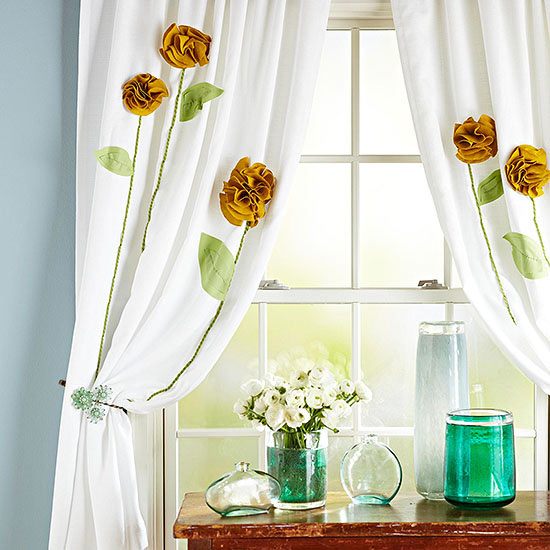
Flower Power
Take plain white curtains up a notch with a simple flower embellishment. To create the rosettes, trace around a 3-inch diameter drinking glass on the flower fabric. Repeat until you have five same-size circles per rosette. Cut out circles and fold into quarters. Hold all the quarter circles in your hand and stitch together with a needle and thread at the base of the flowers. Create the number of rosettes that you want and stitch them to a pair of curtain panels, alternating heights. Run a bead of fabric glue from the flower to the bottom of the curtain panel. Place a length of green yarn on the glue, wrapping it under the bottom edge of the panel and gluing to the back of the curtain. Cut leaf shapes from green cotton fabric and position next to the yarn. Sew a straight stitch down the center and around the edges to secure.



I liked the pom-pom, tuck & fold and stenciled design curtains..
LikeLiked by 5 people
I love pom poms. So easy to make and makes such an impact on the item! I love the fringe too! Thanks for checking them out!❤️️☺️❤️️
LikeLike
My pleasure.. ❤️🤗
LikeLike
☺️❤️️
LikeLiked by 1 person
Lovely!
LikeLiked by 4 people
Thank you mel! Have you entered the giveaway yet?
LikeLiked by 1 person
they are cute
LikeLiked by 4 people
Thank you Jocelyn. Have your entered in the monthly giveaway yet?
LikeLiked by 1 person
No i didn’t know that guess I need to see you blog more.
LikeLike
Love that!!!☺️❤️️
LikeLiked by 1 person
welcome
LikeLike
☺️❤️️
LikeLike
Spectacular curtain ideas. I love the Flower Power ones!
LikeLiked by 4 people
Aren’t those adorable!!! How was your move??
LikeLiked by 1 person
It was okay 🙂
LikeLiked by 1 person
Hmm, you don’t seem over excited! ❤️️☺️❤️️
LikeLiked by 1 person
Just okay???
LikeLiked by 1 person
Well moving is never a party but all is good now that I am here 🙂
LikeLike
Nice, your all settled in! Now the House Warming Party!!!
LikeLiked by 1 person
They look adorable.
LikeLiked by 4 people
Are you going to try one? Pom Poms are very easy to make, and can really make your room so adorable!
LikeLike
Love those tips 😍😍😍
LikeLiked by 4 people
I am so happy you liked them!!🤗❤️️
LikeLike